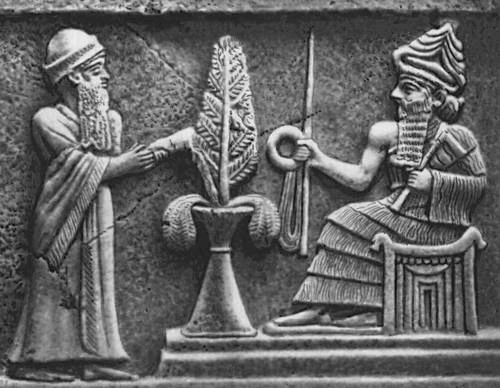People > Ur-Nammu
Ur-Nammu
Background
Ur-Nammu also called Ur-Namma, Ur-Engur, Ur-Gur was a king of Sumer between 2,407 and 2030 BC. He founded the 3rd Dynasty of Ur and was known for reviving Sumer after centuries of rule by the Akkadian Empire and the Gutium.
Ur-Nammu (or Ur-Namma, Ur-Engur, Ur-Gur, ca. 2047-2030 BC short chronology) founded the Sumerian 3rd dynasty of Ur, in southern Mesopotamia, following several centuries of Akkadian and Gutian rule. His main achievement was state-building, and Ur-Nammu is chiefly remembered today for his legal code, the Code of Ur-Nammu, the oldest known surviving example in the world.
Stela or Ur-Nammu
Ur-NammuKing of UrSuccessorShulgiConsortDaughter of Utu-hengalIssueShulgiReligionSumerian religionUr-Nammu (or Ur-Namma, Ur-Engur, Ur-Gur, ca. 2047-2030 BC short chronology) founded the Sumerian 3rd dynasty of Ur, in southern Mesopotamia, following several centuries of Akkadian and Gutian rule. His main achievement was state-building, and Ur-Nammu is chiefly remembered today for his legal code, the Code of Ur-Nammu, the oldest known surviving example in the world.Contents [hide]1Reign2Stele3See also4Notes5External linksReign[edit]Year-names are known for 17 of Ur-Nammu's 18 years, but their order is uncertain. One year-name of his reign records the devastation of Gutium, while two years seem to commemorate his legal reforms: "Year in which Ur-Nammu the king put in order the ways (of the people in the country) from below to above", and "Year Ur-Nammu made justice in the land".[1]Among his military exploits were the conquest of Lagash and the defeat of his former masters at Uruk. He was eventually recognized as a significant regional ruler (of Ur, Eridu, and Uruk) at a coronation in Nippur, and is believed to have constructed buildings at Nippur, Larsa, Kish, Adab, and Umma. He was known for restoring the roads and general order after the Gutian period.[2]A brick stamped with the name of Ur-Nammu of UrUr Nammu was also responsible for ordering the construction of a number of stepped temples, called ziggurats, including the Great Ziggurat of Ur.[3]He was succeeded by his son Shulgi, after an eighteen-year reign. His death on the battle-field against the Gutians (after he had been abandoned by his army) was commemorated in a long Sumerian poetic composition.[2]Stele[edit]In 1925, a shattered nine-foot tall limestone pillar was discovered in Mesopotamia. Under the remote supervision of Leonard Woolley, it was reconstructed by the Penn Museum. In 1985, Jeanny Canby determined that it had been pieced back incorrectly. She removed the plaster filler of the stele, and added the rearranged pieces she found in the museum's storeroom, and discovered the figure of a courtesan embracing a deity. "It's an amazingly intimate scene for a royal monument," she said.[4]See also[edit]Ancient Near East portalSumerian king listNotes[edit]Jump up ^ Year-names for Ur-Nammu^ Jump up to: a b Hamblin, William J. Warfare in the Ancient Near East to 1600 BC. New York: Routledge, 2006.Jump up ^ [1]Jump up ^ Sullivan, Patricia (November 28, 2007). "Archaeologist Jeanny 'Jes' Canby". The Washington Post.External links[edit]Site drawings of the temple built by Ur-Nammu at Ur to the moon god Nanna.Nabonidus dedication to the ZigguratThe Code of Ur-Nammu at BritannicaFoundation Figurine of King Ur-Nammu at the Oriental Institute of ChicagoThe "Ur-Nammu" Stela. Penn Museum. 2006. ISBN 978-1-931707-89-3.